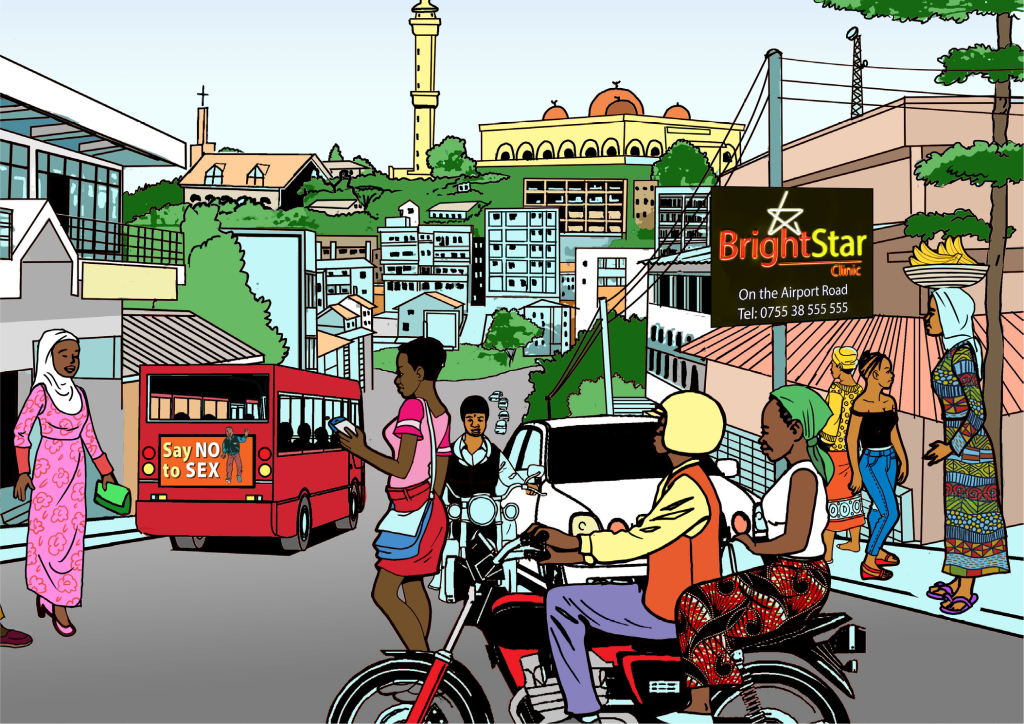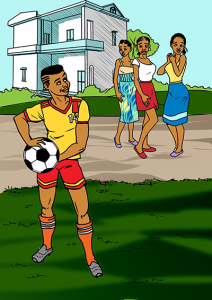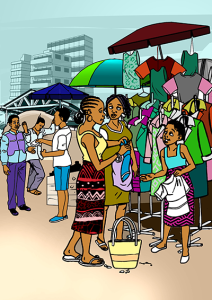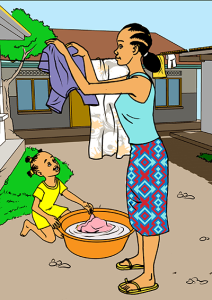Introducing a Fictional Setting
To help demonstrate program planning processes and considerations in the urban context, the I-Kit uses an imaginary program from the fictional city of Zanbe, including the fictional NGO, “Bright Star,” and a fictional cast of urban youth characters. The example of Zanbe, three of its young inhabitants and the Bright Star NGO with its “Let’s Talk About It!” program will be used throughout this I-Kit to show practical examples of how the Essential Elements can be applied.
The three young people presented here, Etienne, Awa and Nadia, represent typical young people, facing the same challenges and aspirations that many young people face in cities elsewhere. We hope that by providing these examples it will help you think about the different aspects when designing SBCC programs addressing urban youth.
The City of “Zanbe”
Zanbe is a growing metropolis in the heart of Tokona, a large African nation. A peaceful country, Tokona’s economy and lifestyle are based mostly on agriculture and farming. However, Zanbe has been attracting foreign investments for several years, thanks to its active commerce industry and foreign workers. As a result, adults and youth from all over the country are moving to Zanbe in search of work, education and better life opportunities.“Bright Star” NGO
![Q-1--Bright-Star-NGO_v3[2]](https://sbccimplementationkits.org/urban-youth/wp-content/uploads/sites/9/2015/09/Q-1-Bright-Star-NGO_v32.png) Bright Star is an NGO in Zanbe, funded by an international donor. Its most recent program, from 2006 to 2011, aims to address the growing problem of unintended pregnancies and STIs among young women 10 to 19 years old. Across Zanbe, Bright Star has three youth-friendly clinics, which also run activities in the community. With the funding, Bright Star targeted out-of-school girls, who they noticed were particularly vulnerable, and developed an SBCC program called Let’s Talk About It! to complement the clinic’s work.
Bright Star is an NGO in Zanbe, funded by an international donor. Its most recent program, from 2006 to 2011, aims to address the growing problem of unintended pregnancies and STIs among young women 10 to 19 years old. Across Zanbe, Bright Star has three youth-friendly clinics, which also run activities in the community. With the funding, Bright Star targeted out-of-school girls, who they noticed were particularly vulnerable, and developed an SBCC program called Let’s Talk About It! to complement the clinic’s work.
In the five years of its funding, Let’s Talk About It! achieved the following results:
- A 17 percent reduction in STIs among the target group.
- A reduction of 21 percent in unintended pregnancies among the target group.
- A 26 percent increase in use of modern contraceptives among the target group.
- Improved communication about sexual health matters among young people and between young people and adults (including their parents).
Bright Star and its Let’s Talk About It! program will be used throughout the I-Kit to illustrate how each Essential Element can be applied for successful programming. Please note that data and information used relating to Zanbe and the Let’s Talk About It! program is fictional, and is presented as a sample scenario only.
Cast of Characters
Amid the hustle and bustle of Zanbe are individuals representing typical urban youth with a range of backgrounds, interests, ambitions and needs. Let’s meet a few of them:Etienne
Etienne is 16 and lives with his family in a middle-class neighborhood in Zanbe. Other than going to school, he loves football and dreams of becoming a professional player one day. He plays football after school and on weekends with his club team, which his father, Thomas, coaches. Etienne is the captain of his team and his friends call him “Strike” because he plays striker, but also because he is “fast” with girls. Sometimes Etienne and his friends go to see movies, or go to bars or clubs to listen to hip-hop music and meet girls. Etienne has had two girlfriends and he has had sex with both. Etienne has used condoms on and off, but almost never uses them if he has been drinking. He knows that condoms prevent pregnancy and STIs, but his friends always say that “condoms kill pleasure.”
Awa
Awa is 11 and lives in a two-room house with her mother in a crowded, poor neighborhood on the outskirts of Zanbe. Awa dropped out of school for two years when she was 9. Recently, she managed to go back to school, but often misses classes because her mother does not always have the money to pay for the school fees. Awa sells clothes in the Central Market after school to contribute to the small household income. After work, Awa loves hanging out with friends at the night market or around cafes instead of going home, where her mother sells homemade alcohol. The men coming through her living room buying the alcohol are often drunk and try to touch and talk to her, which she hates. Awa has been getting more attention lately from men as her body is developing. She hears others around her talking about sex, but she is not interested. She dreams of finishing school so she can get a better job in one of the city’s tall buildings.
Nadia
Nadia is 18 years old and lives in a good neighborhood with her daughter, her older sister, her sister’s husband and their two children. When she was 15, Nadia’s boyfriend told her she could not get pregnant the first time they had sex, but she got pregnant and had to quit school when her daughter was born. Her parents were not supportive, so she came to Zanbe to live with her sister. Nadia takes care of her daughter and her niece and nephew, cleans the house and prepares food for the family. She does not have much free time and misses her friends back home, but hangs out with a few friends in the city. She has not heard from the father of her child since she told him she was pregnant, but has recently started dating a man she met at the nightclub. After the birth of her daughter, the nurses told her about the injectable and she uses this method so she can plan her next pregnancy, but knows that she should also use condoms to prevent STIs.





